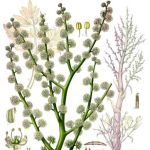| Common Name: |
Ammoniac Gum |
| Other Names: |
Ammoniac |
| Botanical Name: |
Dorema ammoniacum |
| Genus: |
Dorema |
| Family: |
Apiaceae |
| Native Location: |
Iran to Afghanistan and Pakistan |
| Cultivation: |
Well-drained to dry, stony soil in sun. |
| Propagation: |
By seed sown in autumn or spring |
| Harvest: |
Gum resin is collected from incisions in stems and leaf stalks during the flowering and fruiting periods. It is solidified into "tears" or blocks before grinding into powder. |
| Height: |
2-3m (6-10ft) |
| Width: |
1-1.5m (3-5ft) |
| Hardiness: |
Z7-9 |
| Parts Used: |
Gum resin |
| Properties: |
A strong smelling, acrid, stimulant herb that has expectorant effects, relaxes spasms, and increases perspiration. |
| Medicinal Uses: |
Internally for chronic bronchitis (especially in the elderly), asthma, or excess mucus. Externally for swollen joints and indolent tumors. |
| Economic Uses: |
Formerly used in perfumery and in porcelain cement. |
| Bibliography: |
Encylopedia of Herbs by Deni Brown Copyright ©: 1995, 2001 Dorling Kindersley Limited pp 196
|

